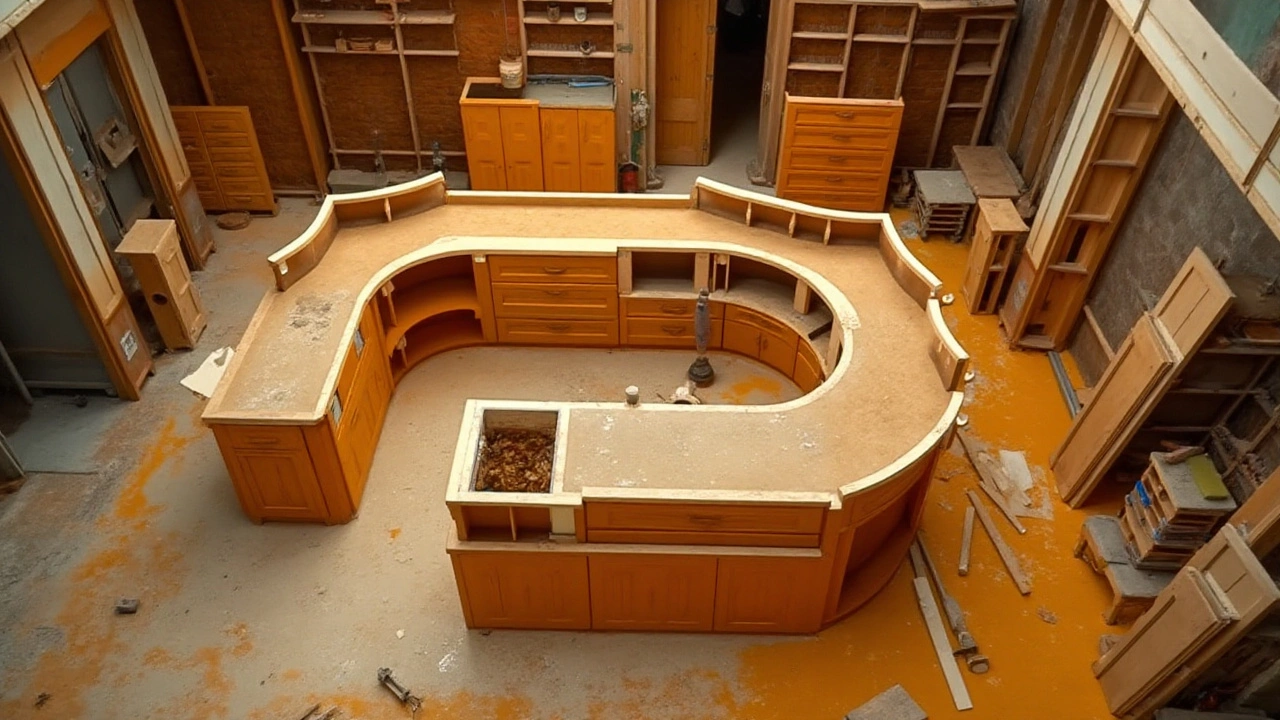The Costliest Aspect of Kitchen Remodeling Uncovered

Renovating a kitchen is both an exciting and challenging endeavor, often seen as the heart of a home, where creativity and functionality meet. However, transforming this space to meet your vision can come at a considerable cost. The thrill of designing your dream kitchen might quickly be overshadowed by the reality of budgeting.
Understanding the nature of kitchen remodel expenses is crucial. From sleek countertops to custom cabinetry, these components can significantly impact your wallet. In this article, we will dive into the details of the most expensive aspects of kitchen remodeling, offering insights that will help you plan wisely and make informed decisions. Whether you're taking on a small upgrade or a complete overhaul, these insights could be invaluable in creating a space that's both beautiful and financially manageable.
- Cabinetry Costs
- Countertops and Flooring
- Appliances and Fixtures
- Labor and Installation Fees
- Tips for Budget Management
Cabinetry Costs
In the realm of kitchen remodel expenses, cabinetry stands out as the leading contender for costs. These storage wonders not only define the aesthetic of your space but also significantly influence functionality, making them a key focal point in any renovation project. When breaking down the expense, it's important to first consider the material of the cabinets. Solid wood is often preferred for its durability and visual appeal, yet it can be a hefty part of the budget. Alternatives like MDF or plywood offer a balance between cost and quality, but it really boils down to personal preference and desired longevity.
Customization also plays a pivotal role in cabinetry costs. Custom-built cabinets can soar to extravagant prices due to the labor intensity and craftsmanship involved. According to a report from the National Kitchen and Bath Association, custom cabinets can account for up to 40% of the overall remodeling budget. On average, homeowners might spend anywhere from $500 to $1,200 per linear foot on custom options, while semi-custom cabinets are slightly more affordable, allowing some level of modification without that fully bespoke price tag.
Choosing the Right Fit
Finding the right balance between cost and utility is crucial. When selecting cabinets for your kitchen remodel, it’s vital to evaluate your needs comprehensively. Are you looking for more storage? Or perhaps ease of access is your top priority? Features like soft-close hinges, pull-out shelves, and built-in organizers can add functionality but often increase costs. Interestingly, opting for standard-sized cabinets and tweaking the design around them can save a significant chunk of money without compromising too much on the aesthetic front.For a truly budget-conscious approach, consider refacing your existing cabinets if they are structurally sound. This process, which involves replacing only the door fronts and veneering the cabinet boxes, can dramatically alter the look of a kitchen at a fraction of the price of new cabinetry. According to HGTV, cabinet refacing costs typically range between $4,000 and $9,000, a stark contrast to the potential $40,000 investment in new, top-of-the-line custom cabinetry.
"Quality cabinetry is an investment that can elevate the value of your home," says interior designer Jane Lockwood. "However, smart choices can ensure you don’t overshoot your budget while still achieving a kitchen that's both functional and stunning."
The Cost of Hardware and Installation
Finally, cabinetry hardware and installation are additional factors to consider in the total cost equation. Handles, knobs, and pulls can vary widely in price, from a few dollars each to custom-designed fixtures that can reach upwards of $100 per piece. Installing cabinets is labor-intensive and thus contributes a notable portion to costs. Proper installation ensures longevity and functionality, making it a worthwhile investment, even if it means splurging a bit on skilled labor.Countertops and Flooring
When embarking on a kitchen remodel, countertops and flooring often present some of the heftiest price tags. These elements not only define the look of your kitchen but also its functionality. Granite and quartz remain popular choices for countertops, each offering durability and an aesthetic appeal that can transform your space. While granite provides a natural stone elegance, quartz offers a wider range of colors and patterns, often at a lower maintenance cost. However, these options can range from $2,000 to over $5,000 installed, depending on the area covered and edge treatments. As such, understanding your lifestyle needs and selecting the right materials is crucial. For instance, if you're often in the kitchen, opting for a surface that withstands high temperatures and resists stains can save you time and replacement costs down the line.
Flooring encompasses a similarly vast landscape of choice under the realm of kitchen installations. Hardwood floors, celebrated for their timeless appeal, must be treated carefully in kitchens due to moisture exposure. Alternatively, vinyl and laminate options offer water resistance and budget-friendly prices. Depending on your choice, costs for flooring materials, alongside installation charges, can vary widely, with eco-friendly options like bamboo or cork also entering the fray due to increased sustainability awareness. It's said that these green alternatives can sometimes lend warmth and comfort underfoot while contributing positively to environmental considerations.
Reflecting on the significance of these choices, interior decorating expert Sarah Richardson once said,
"Your kitchen counters and floors are more than just surfaces—they're where life happens. Pick what makes you comfortable and reflects your style."Her sentiment captures the essence of why these components deserve special attention. Striking the right balance between practical functionality and visual harmony can elevate your kitchen from mundane to mesmerizing, making it a central hub for gatherings. When contemplating countertops and flooring, it's beneficial to consider not only upfront costs but also the longevity and ongoing maintenance involved. Long-term investments in quality materials often repay themselves in resilience and home value.
If you're diving into stats, consider that kitchens with high-end countertops and floors can see a return on investment (ROI) ranging typically from 50-60% upon the sale of a home. Here's a simple breakdown illustrating typical cost range:
| Countertop Material | Approx. Cost per Sq. Ft. |
|---|---|
| Granite | $40 - $100 |
| Quartz | $50 - $150 |
| Laminates | $10 - $40 |

Appliances and Fixtures
When diving into a kitchen remodel, selecting the right appliances and fixtures is akin to putting the cherry on top of an elaborate cake. These choices can elevate the kitchen's aesthetic appeal and functionality, making it an integral hub of daily life. High-end appliances are not only about sleek designs but also about technological advancements that ensure energy efficiency and precision in cooking. For instance, induction cooktops are becoming increasingly popular due to their rapid temperature adjustments and safety features, as they stay cool to the touch. Stainless steel remains a timeless choice for refrigerators and ovens, showcasing a seamless blend of modernity and elegance.
Fixtures, including faucets and lighting, contribute significantly to a kitchen's character and practicality. For faucets, pull-down models with dual spray functions have become a favorite, offering flexibility and ease of use. Though the initial investment for sensor-operated faucets might be high, their water-saving benefits pay off in the long run. Meanwhile, lighting plays a pivotal role, not just for visibility but for ambiance, too. LED under-cabinet lighting offers both, conserving energy while bouncing light beautifully off glossy countertops.
"A well-designed kitchen is not complete without the careful selection of the right appliances and fixtures," says renowned interior designer Sarah Richardson.
She once aptly noted, "A kitchen's personality is undoubtedly shaped by the details—the rhythm of a perfect melody played by its appliances and fixtures."An aspect often overlooked yet crucial is ensuring that the selected pieces fit within the kitchen's design constraints. This encompasses everything from dimensions to finishes, maintaining a cohesive look without compromising usability.
Indeed, sophisticated gadgetry like integrated in-cabinet microwaves, silent dishwashers, and smart refrigerators that allow you to peek inside through an app are no longer out of reach. Yet, these innovations come with a price tag. For those watching their budget, seeking appliances with efficient use of space and energy can result in both short-term savings and long-term value. It's also worth exploring scratch-and-dent outlets or considering last season's models, which might offer premium features at reduced prices.
Investments in these areas are often substantial, sometimes extending into a five-figure range, particularly if you opt for a high-tech setup. But fret not, because there are always ways to circumvent the overwhelming pressure on the purse. Appliances and fixtures are where many homeowners can exercise their bargaining power and creativity. A harmonious balance between luxury and frugality can be achieved without sacrificing quality.
For a better grasp on managing costs effectively, consider creating a priority list. Identify which features are non-negotiable—perhaps a premier gas range for the cooking enthusiast or a whisper-quiet dishwasher in an open-concept space. By distinguishing between must-haves and nice-to-haves, homeowners can allocate their budget wisely. This strategic approach enables both functionality and finesse, with appliances and fixtures that will likely lead to a timeless and efficient kitchen environment.
Labor and Installation Fees
The hidden costs of labor and installation fees often take homeowners by surprise during a kitchen remodel. From plumbers to electricians, the experts you hire to bring your vision to life come at a premium, yet their expertise is invaluable in achieving a seamless renovation. According to the National Kitchen and Bath Association, labor can account for up to 20-35% of your total remodeling budget, making it a sizable investment in any project. Skilled professionals handle everything from tearing out existing fixtures to installing complex systems, requiring a variety of technical skills that are crucial for ensuring quality and safety standards are met.
When exploring labor costs, it’s important to consider the geographical location of your home, as prices can vary considerably across the United States. For instance, metropolitan areas with a high cost of living like New York or San Francisco might demand higher fees for skilled labor compared to rural regions. Additionally, the complexity of the design significantly impacts costs. A remodel that involves moving plumbing, electrical wiring, or gas lines will generally incur higher labor expenses due to the intricacies involved. It's crucial to outline these needs early in the planning phase to avoid unexpected increases in your budget.
"Investing in quality labor is investing in peace of mind," says John McGillivray, a veteran contractor with over 20 years of experience. "Cutting corners here might offer short-term savings, but it could lead to long-term issues that are far pricier to fix."
Given the expenses associated with installing premium kitchen features such as high-end cabinets and countertops, selecting experienced contractors ensures the longevity and durability of the installation. Homeowners should consider seeking multiple quotes and checking references. Additionally, understanding the breakdown of labor costs can provide transparency and help in negotiating a fair price. Requesting a detailed estimate that segments out labor from materials can be illuminating, revealing where exactly your money is going.
It's essential to also account for any permits required for the renovation, which can add to overall labor costs. These permits ensure compliance with building codes and regulations, safeguarding the structural integrity of your home. While it might be tempting to save money by tackling some elements of the remodel as a DIY, it is worth noting that mistakes in plumbing or electrical work can be hazardous and costly to repair. Therefore, reserving DIY projects for areas like painting or non-structural cosmetic changes is typically advisable.
The benefit of professional installation not only lies in achieving a polished end result but also includes warranties that provide protection against future issues. Partnering with reputable contractors often means gaining access to solid warranties on both labor and materials, which is a crucial consideration for long-term satisfaction. As you plan your kitchen remodel, keeping these labor and installation fees in mind ensures that you’re more prepared to handle the financial and procedural components of transforming your kitchen into a functional and stylish space.

Tips for Budget Management
When embarking on a kitchen remodel, managing your budget effectively can make all the difference between a peaceful upgrade and a financial headache. It's essential to first establish clear objectives for what you want to achieve with your renovation. Begin by assessing what is truly necessary for your lifestyle. Are high-end appliances a must, or could mid-range ones suit your needs just as adequately? A detailed wish list, ranked by priority, can help maintain focus and guide spending decisions throughout the process. Be sure to take into account the unexpected costs – they are bound to arise. Building a contingency fund of around 15-20% of your total budget can cushion any surprise expenses, leaving room for those creative extras that might just pop up along the way.
The next aspect to consider is the scope of work that you plan to undertake by yourself versus hiring professionals. While DIY projects are cost-effective and provide a sense of accomplishment, not every task is suitable for self-completion, especially those requiring specialized skills. For example, while painting might fall within your skillset, installing a complicated cabinetry system or working with electrical fixtures might not. It's crucial to realistically evaluate your abilities to prevent mistakes that could lead to even higher repair costs later. Hiring a qualified professional to handle installations can actually save money in the long run by ensuring that the job is done right the first time.
Being savvy about where to splurge and where to save can have a significant impact. Choose elements that will have lasting appeal and value, such as investing in durable countertops and reliable appliances rather than expensive yet fleeting decor trends. A practical trick is mixing materials: you might splurge on a gorgeous island countertop while opting for more affordable options on the perimeter. This approach provides contrast and personality and helps maintain budget balance. Remember, it's about creating a space that feels luxurious without overshooting financial boundaries.
"Start with a clear budget and stick to it," advises HGTV expert Scott McGillivray. "Prioritize what matters most to you and know when you're getting good value. Balancing quality with cost efficiency is key."
Strategic timing can also contribute to cost-efficiency. Plan your kitchen installations or upgrades during off-peak seasons when labor and materials may be more affordable. Retailers often have sales during certain times of the year, allowing you to purchase big-ticket items like appliances at a reduced rate. Another approach is to buy gently used or refurbished items, which can offer a high-quality look at a fraction of the cost of brand-new products.
Write a comment